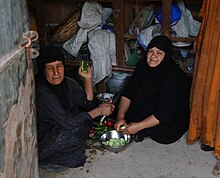Women's rights in Iraq

Iraqi women in their kitchen preparing a meal for a luncheon.
|
|
| Gender Inequality Index | |
|---|---|
| Value | 0.557 (2012) |
| Rank | 120th |
| Maternal mortality (per 100,000) | 63 (2010) |
| Women in parliament | 26.5% (2014) |
| Females over 25 with secondary education | 22.0% (2010) |
| Women in labour force | 16% (2014) |
| Global Gender Gap Index | |
| Value | NR (2012) |
| Rank | NR out of 144 |
The status of women in Iraq at the beginning of the 21st century is affected by many factors: wars (most recently the Iraq War), sectarian religious conflict, debates concerning Islamic law and Iraq's Constitution, cultural traditions, and modern secularism. Hundreds of thousands of Iraqi women are widowed as a result of a series of wars and internal conflicts. Women's rights organizations struggle against harassment and intimidation, while they work to promote improvements to women's status in the law, in education, the workplace, and many other spheres of Iraqi life, and to curtail abusive traditional practices such as honor killings and forced marriages.
To appreciate women’s achievements in this society, it is important to look at the history of their position in the society and how wars and successions in dynasties and governments have affected women's roles.
During the seventh century the lamas as a part of their conquest were fighting the Persians, who were defeated. As Doreen Ingrams, the author of The Awakened: Women in Iraq, noticed, (p. 20). It was a time when women’s help was needed. In particular, a woman called Amina bint Qais “at the age of seventeen was the youngest woman to lead a medical team in one of these early battles. After their victory, the Arabs that began ruling Mesopotamia named that country Iraq. In 750 AD, during the Abbasid Caliphate, women “became renowned for their brains as well as their beauty” (p. 22). However, even then many girls were being captured as slaves. Despite that fact, “many of the well-known women of the time were slave girls who had been trained from childhood in music, dancing and poetry. Another feminine figure to be remembered for her achievements was Tawaddud, “a slave girl who was said to have been bought at great cost by Haroun al Rasid because she had passed her examinations by the most eminent scholars in astronomy, medicine, law, philosophy, music, history, Arabic grammar, literature, theology and chess” (p. 23). Moreover, among the most prominent feminine figures was Shuhda who was known as “the Scholar” or “the Pride of Women” during the twelfth century in Baghdad. Despite the recognition of women’s aptitudes during the Abbasid dynasty, all these were reversed in 1258 when Baghdad was attacked by the Mongols. After that, the city of Baghdad was “given over to an orgy of massacre, plunder and devastation […]”. With the departure of the Mongols a succession of Persian rivalries followed until 1553, when the Ottoman Sultan Suleiman captured Baghdad and its provinces, which became parts of the Turkish empire.
...
Wikipedia
